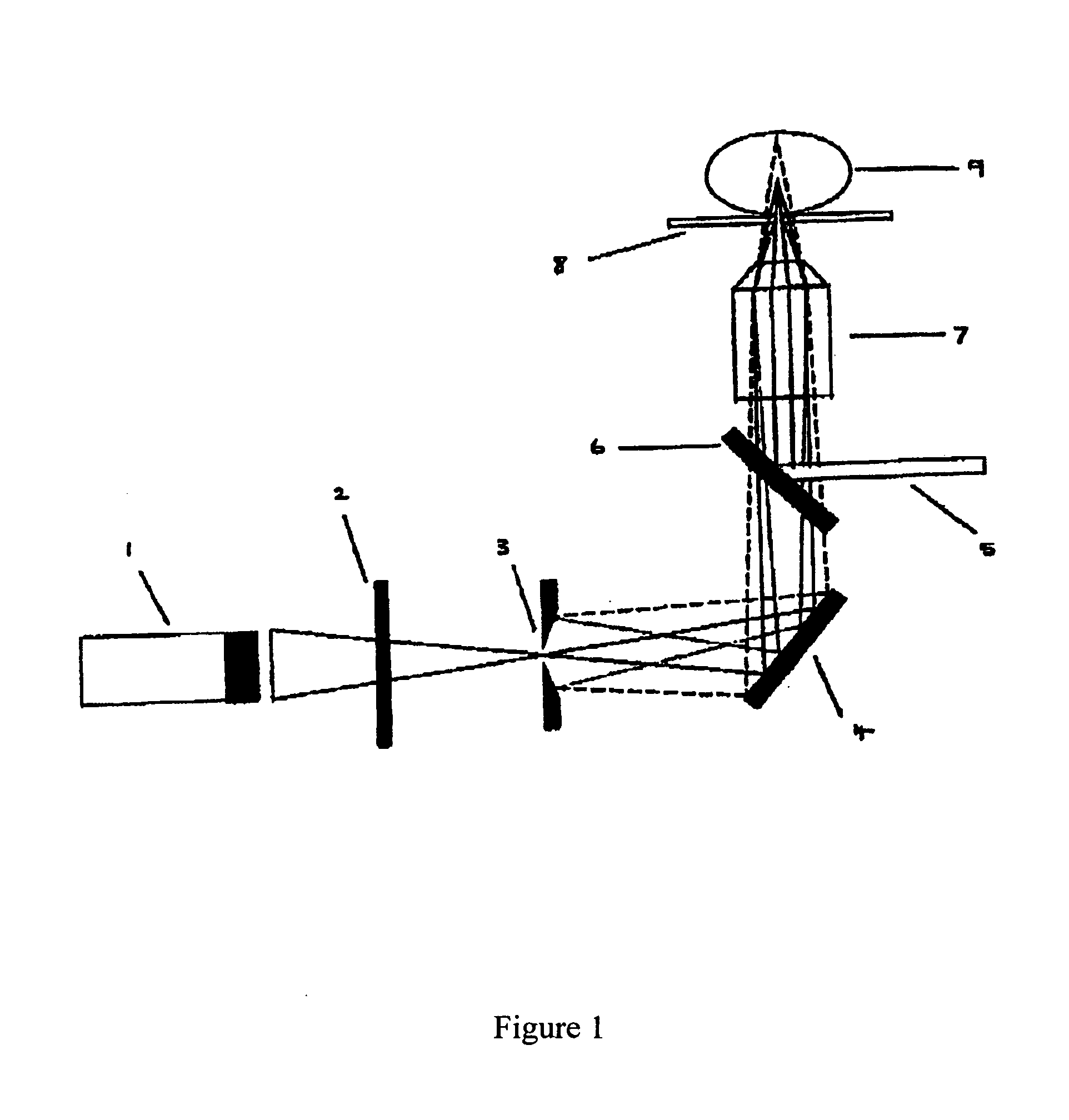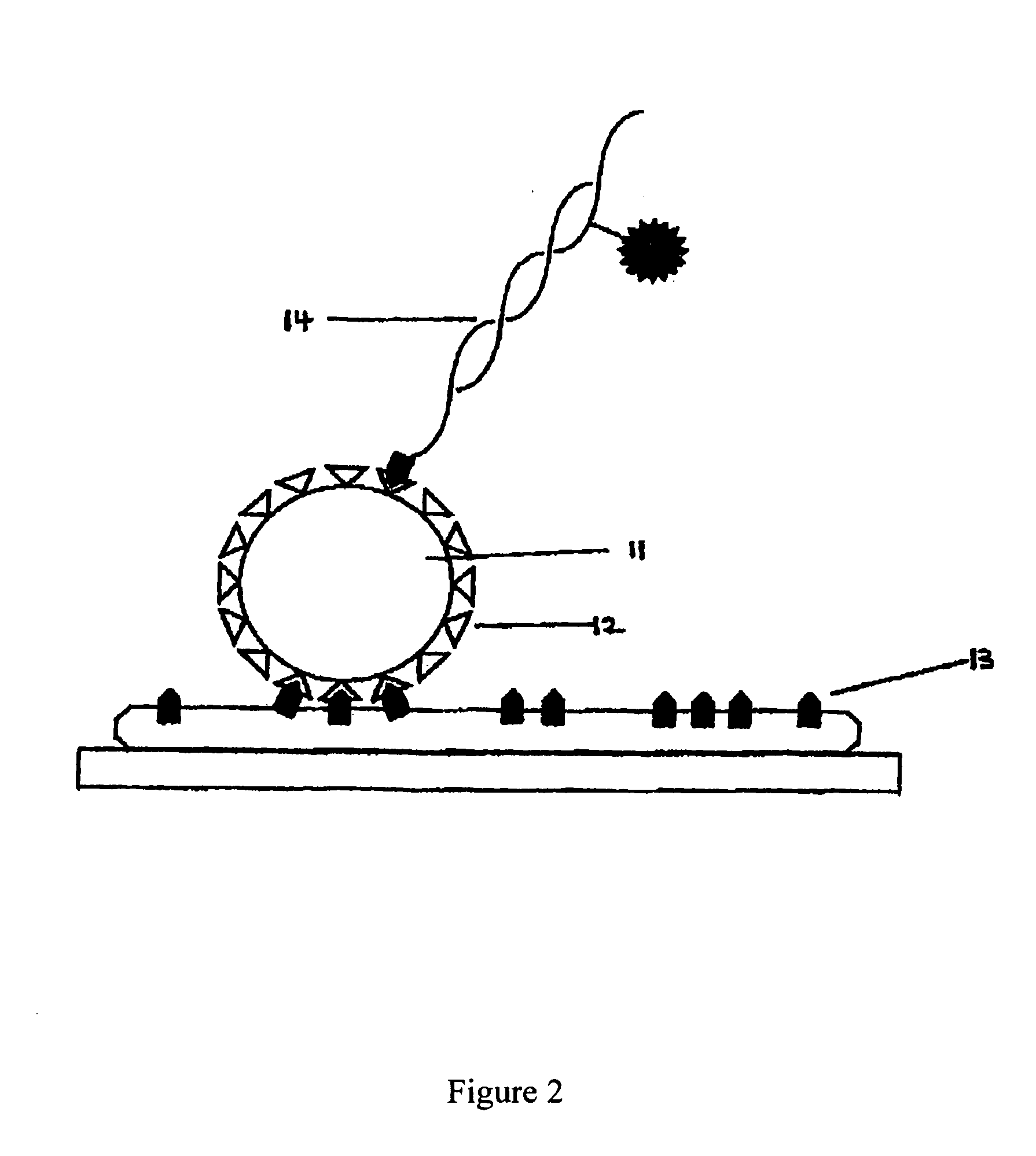Method and system for sequencing polynucleotides
- Summary
- Abstract
- Description
- Claims
- Application Information
AI Technical Summary
Benefits of technology
Problems solved by technology
Method used
Image
Examples
example 4
[0132]This Example illustrates the preparation of single molecule arrays by direct covalent attachment of hairpin loop structures to glass.
[0133]A solution of 1% glycidoxypropyltrimethoxy-silane in 95% ethanol / 5% water with 2 drops H2SO4 per 500 ml was stirred for 5 minutes at room temperature. Clean, dry Spectrosil-2000 slides (TSL, UK) were placed in the solution and the stirring stopped. After 1 hour the slides were removed, rinsed with ethanol, dried under N2 and oven-cured for 30 min. at 100° C. These ‘epoxide’ modified slides were then treated with 1 μM of labelled DNA (5′-Cy3-CTGCTGAAGCGTCGGCAGGT-heg-ami-nodT-heg-ACCTGCCGACGCT-3′) (SEQ ID NOS. 6 and 7) in 50 mM potassium phosphate buffer, pH 7.4 for 18 hours at room temperature and, prior to analysis, flushed with 50 mM potassium phosphate, 1 mM EDTA, pH 7.4. The coupling reactions were performed in sealed teflon blocks under a pre-mounted coverslip to prevent evaporation of the sample and allow direct imaging.
[0134]The DNA s...
example 1
[0205]Glass slides were cleaned with decon 90 for 12 hours at room temperature prior to use, rinsed with water, EtOH and dried. A solution of glycidoxypropyltrimethoxysilane (0.5 mL) and mercaptopropyltrimethoxysilane (0.0005 mL) in acidified 95% EtOH (50 mL) was mixed for 5 min. The clean, dried slides were added to this mixture and left for 1 hour at room temperature rinsed with EtOH, dried and cured for 1 hour at 100° C. Maleimide modified DNA was prepared from a solution of amino-DNA (5′-Cy3-CtgCTgAAgCgTCggCAggT-heg-aminodT-heg-ACCTgCCgACgCT; SEQ ID NO:8) (10 μM, 100 μL) and N-[g-Maleimidobutryloxy]succinimide ester (GMBS); (Pierce) (1 mM) in DMF / diisopropylethylamine (DIPEA) / water (89 / 1 / 10) for 1 hour at room temperature. The excess cross-linker was removed using a size exclusion cartridge (NAPS) and the eluted DNA freeze-dried in aliquots and freshly diluted prior to use. An aliquot of the maleimide-GMBS-DNA (100 nM) was placed on the thiol surface in 50 mM potassium phosphate...
example 2
[0209]Slides were cleaned with decon 90 for 12 hours prior to use and rinsed with water, EtOH and dried. A solution of tetraethoxysilane (0.7 mL) and N-(3-triethoxysilylpropyl)bromoacetamide (0.0007 mL) in acidified 95% EtOH (35 mL) was mixed for 5 minutes. The clean, dried slides were added to this mixture and left for 1 hour at room temperature, rinsed with EtOH, dried and cured for 1 hour at 100° C. Phosphorothioate modified DNA (5′-TMR-TACCgTCgACgTCgACgCTggCgAgCgTgCTgCggTTsTsTsTsT ACCgCAgCACgCTCgCCAgCg; SEQ ID NO:9) where s=phosphorothioate (100 pM, 100 μL) in sodium acetate (30 mM, pH 4.5) was added to the surface and left for 1 hour at room temperature. The slide was washed with a buffer containing 50 mM Tris / 1 mM EDTA.
[0210]Imaging was performed as described in Example 1 and a good dispersion of single molecules was seen (FIG. 6b).
PUM
| Property | Measurement | Unit |
|---|---|---|
| Fraction | aaaaa | aaaaa |
| Fraction | aaaaa | aaaaa |
| Distance | aaaaa | aaaaa |
Abstract
Description
Claims
Application Information
 Login to View More
Login to View More - R&D
- Intellectual Property
- Life Sciences
- Materials
- Tech Scout
- Unparalleled Data Quality
- Higher Quality Content
- 60% Fewer Hallucinations
Browse by: Latest US Patents, China's latest patents, Technical Efficacy Thesaurus, Application Domain, Technology Topic, Popular Technical Reports.
© 2025 PatSnap. All rights reserved.Legal|Privacy policy|Modern Slavery Act Transparency Statement|Sitemap|About US| Contact US: help@patsnap.com



